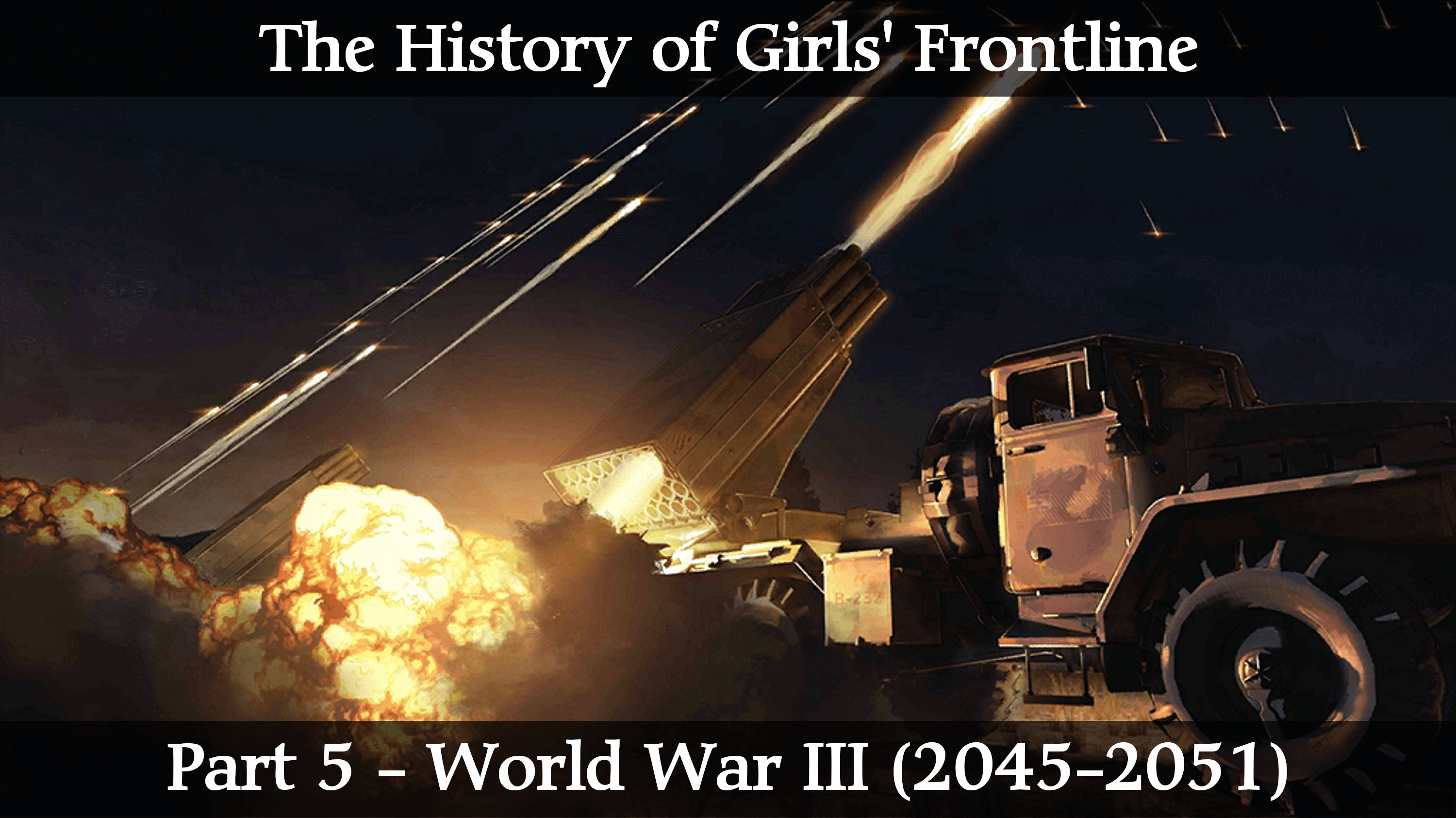Phases of WWIII

On March 2nd, 2045, the world was once again thrown into the inferno. The deadliest conflict in human history, World War III, began with an onslaught of nuclear launches. The war was divided into three phases, each with its own form of devastation. Phase one began on the 2nd with an exchange of ICBMs, and slowly developed into saturation bombings of several countries. The second phase of the war began following the end of said bombings. As ballistic missiles were proving ineffective and becoming fewer in number, the warring nations turned to high-intensity nuclear airstrikes for their attacks. By the end of the second phase, much of the world’s air forces and navies had been destroyed but the majority of ground forces were still capable, forcing the war to change into a ground war over arable land. Phase three would come to be the longest and deadliest period of the entire conflict.
WWIII Phase I
The first phase of the war began with nuclear ballistic missile launches across the globe. Among the first wave of ICBM strikes, the majority failed to reach their targets, detonated off-course, or were intercepted by recent anti-ballistic missile defense systems. The contamination caused by both the Beilan and Northern Lights Incidents caused various nations to lose access to their satellites. While never implicitly stated, Hubble’s profile in Neural Cloud implies a Kessler Syndrome event took place to some degree. Whether this was caused by respective nations losing control of their satellites pre-war or with anti-satellite missiles is unstated. The loss of guidance caused multiple missiles to malfunction, leading to them straying off course. In addition to the loss of guidance, recent developments in anti-ballistic missile technology allowed for many of the missiles to be intercepted mid-flight.
WWIII Phase II
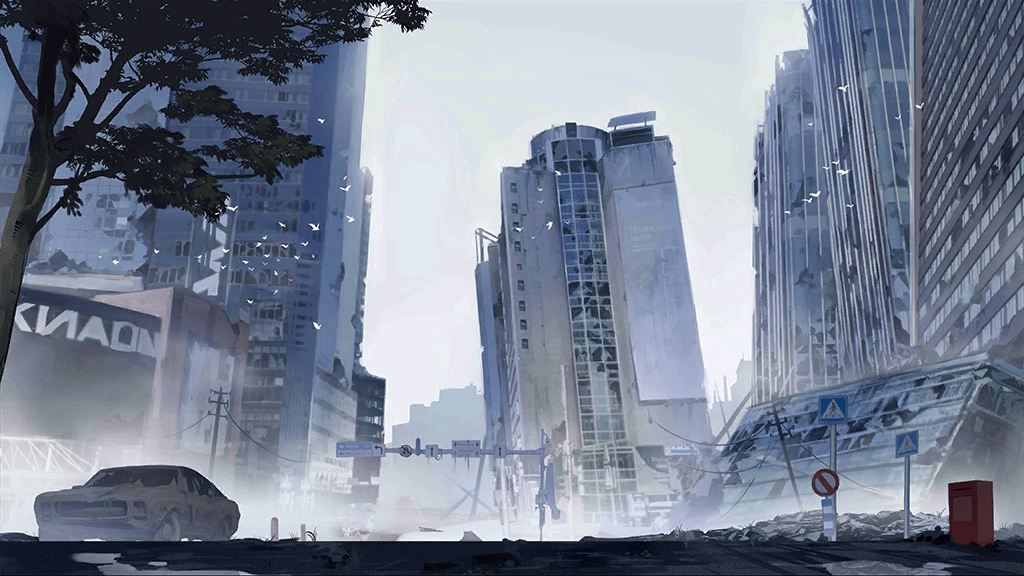
During the immediate aftermath, it was clear precision strikes was proving to be ineffective, and the choice was made to turn to saturation bombings to ensure some weapons would make their targets. While the second wave of strikes was underway, Soviet submarines, with a lack of communications, detected launches. After determining that nuclear war had begun, they fired their submarine-launched ballistic missiles (SLBMs) toward their enemies. The SLBMs suffered many of the same issues as the initial exchange. Regardless of failures or successes, the bombings grew more intense as countries gradually shifted away from ballistic missiles and toward nuclear airstrikes conducted by their air forces.
The second phase of WWIII began with an escalation of the nuclear war. Phase two took place primarily as three immense air and naval campaigns between nations for the defense of their nuclear bombers during strikes. To break through enemy defenses, several nations mounted warheads on cruise missiles so they could be fired to clear paths for their bombers. From there, the bombers would be able to deliver more accurate strikes.
By the end of the second phase, most of the world's naval and air forces had been destroyed. Multiple key cities had faced catastrophic damage, but the specifics are not known at this time. The only city confirmed to have suffered damage by nuclear attack was Moscow during the first day of the war. A single warhead from a Minuteman III breached the city’s anti-ballistic missile system, striking the railyard in the early morning. Following the ending of nuclear attacks and the loss of air and naval forces, the third phase of the war commenced. The loss of so much livable land due to the Collapse Fluid pollution and the bombings resulted in a change of strategy. Without air and sea support, the war morphed into a severe and protracted ground war over the control of uncontaminated zones. The third phase would see the deadliest fighting of the war and would see the eventual use of both Doll and multi-legged robots during various campaigns in Europe.
WWIII Phase III
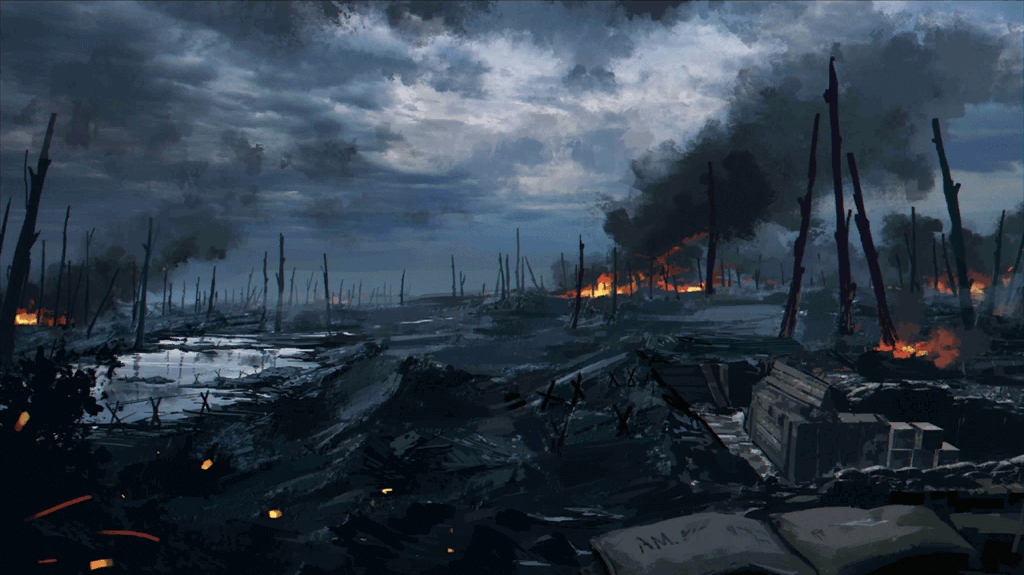
The destruction inflicted by the nuclear war drastically shifted the war strategy of all sides. The war’s primary goal turned to the control of the uncontaminated regions. The war entered a deadly, five-year-long conflict between East and West. Much of the land fought over during the third phase resided in Africa and parts of Europe, resulting in these regions becoming hotbeds.
Not much is known about the ground war early on aside from the specific regions being fought over. For the first two years, the frontlines shifted back and forth between the warring nations. For the Soviets, some Dolls were used to maintain supply lines but remained relatively uninvolved in the war effort until later on. The war increased in intensity in the spring of 2047 following the US military entering Western Europe. For the next several months, the West European theater became one of attrition with losses stacking up daily. Lines shifted back and forth; however, in May, the Americans launched several invasions into Germany. Within the Soviet Ministry of Defence (MoD), the severity of the threat was far too great, but they lacked the men to push back the American forces. The plan of using military Doll robots to assist in the counter-attack was soon brought to the forefront of the MoD.
Three months later, in August 2047, the US continued its campaign in Germany, eventually launching an invasion into Berlin. In an attempt to halt the Americans, the MoD was forced to deploy the combat Dolls early. Despite taking many losses, the Dolls were successful in their defense of the city. The invaders were pushed back, and the city remained under the control of the East Germans and the NUSSR. The success of Tactical-Dolls sparked a new interest in using Dolls in warfare, but the war was still far from over. By November, North Africa had become a battleground between NATO and Soviet forces.
War in North Africa
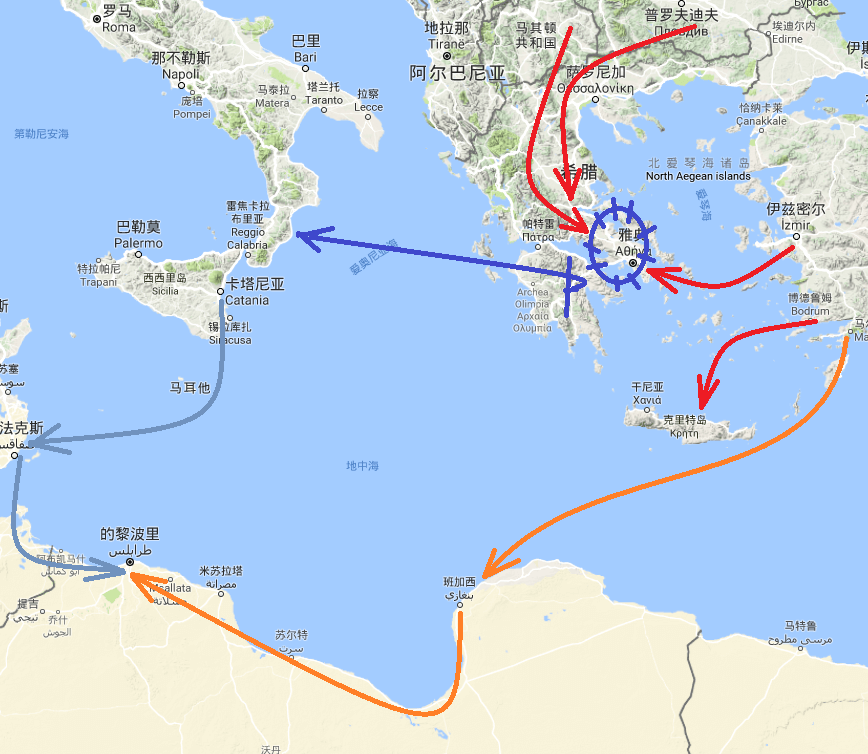
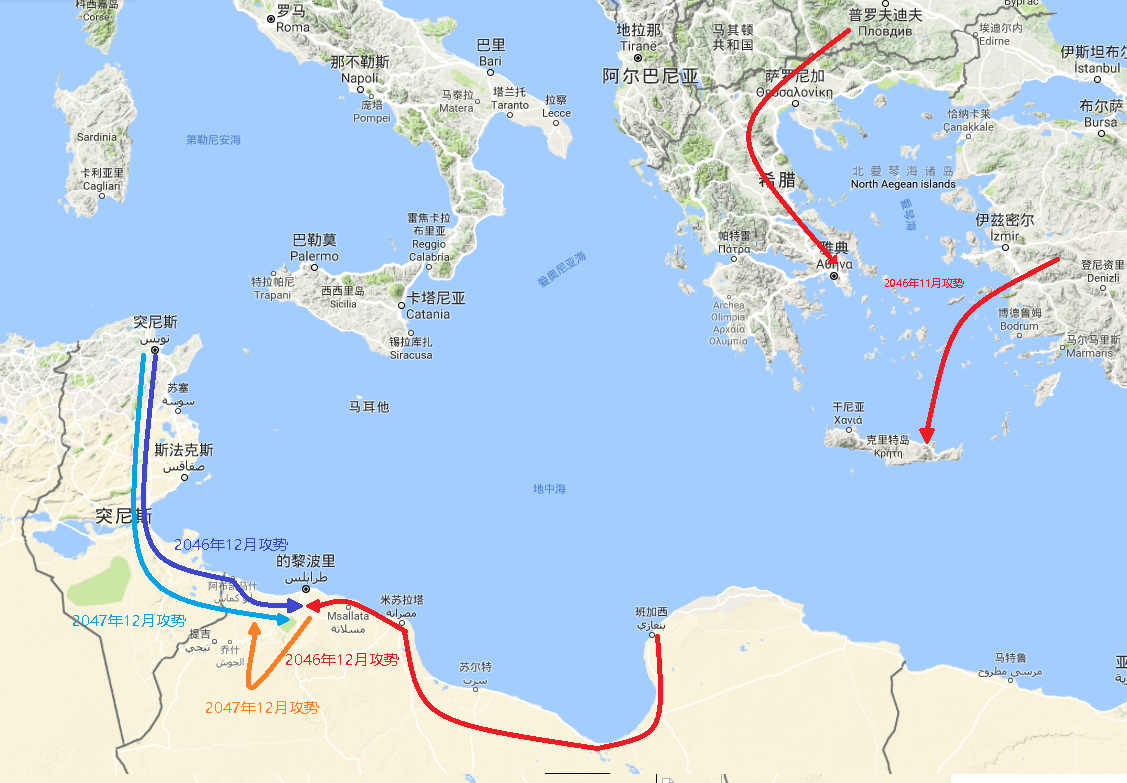
Maps of the Soviet/Warsaw Pact invasion of Greece, Soviet and NATO landings in North Africa, and the battle of Tripoli in late 2047. This map may not be entirely canonical.
Throughout the past several months, the Soviets had pushed into North Africa, taking over parts of Libya. Tripoli had fallen under the control of the Soviets, acting as a strategically important city in the region. Troops were brought in to keep hold of the city; many of whom were operating with Dolls. For Captain Berezovich Kryuger, who was in the city at the time, Dolls were just another weapon for his men to use on the battlefield. Later that November, NATO forces mobilized fifteen French armored brigades to the west in the coastal village of Abu-Kammash. They planned to launch a series of strikes against the missile sites defending Tripoli. From there, they would be able to capture the city, forcing the Soviets out. In response, the Soviets planned to counter the assault by conducting an ambush near the west of Bir-Gennom/Bir al-Ghanam. If the French tanks could be taken out, the assault on Tripoli would effectively be over before it even began.
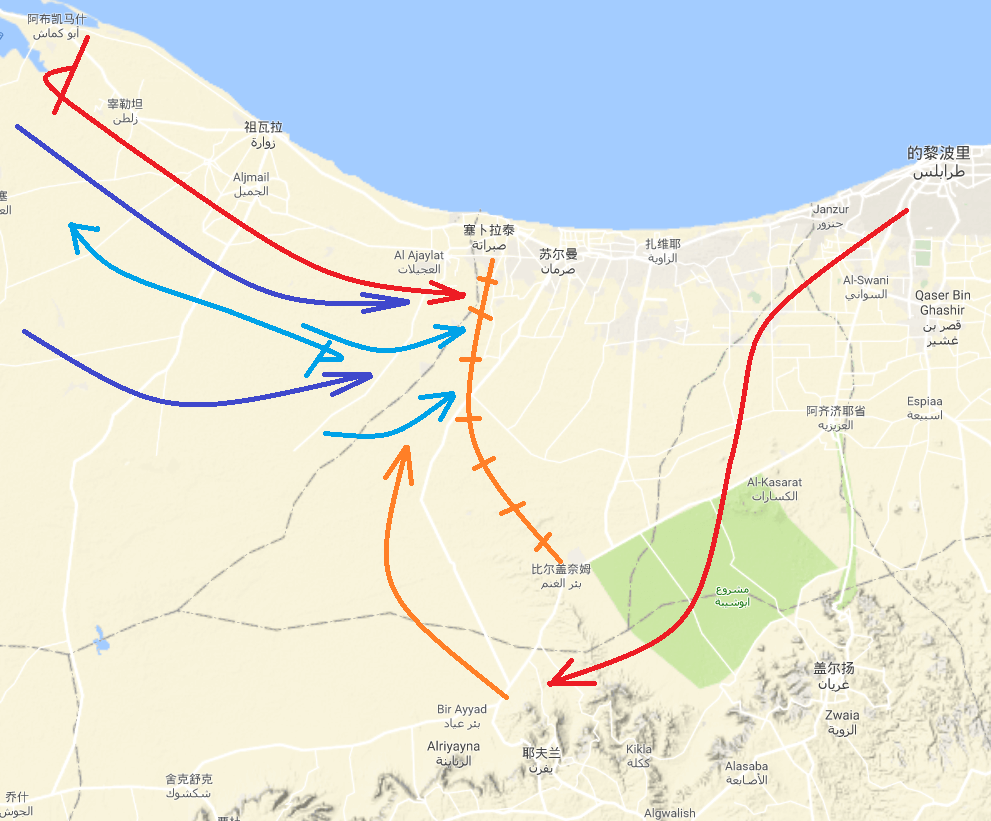
Map of the Soviet and East German defense of Sabratha and Tripoli in December 2047. This map may not be entirely canonical.
By December 12th, the Soviet encampment in Bir-Gennom became the frontline of their defense against the approaching NATO brigades. Earlier in the day, a 4km wide gap opened near the city of Sabratha, and Soviet command ordered Soviet and German troops to move north to plug and hold the breach. Soviet battalions in the south and motorized infantry in the north were sent to fill the gap and hold the line long enough for their main force to arrive. From there, the 336th Attack Helicopter Squadron would begin providing support for the forces within the bulge, continuing to hold the line long enough for the main force to eliminate several NATO mechanized infantry brigades. The result of this battle is currently unknown.
War in China and Germany

Map of the American invasion of Southern China from 2045 to 2048 before the Chinese counterattacks in the following years. This map may not be entirely canonical.
The bloody conflict continued throughout the late 2040s, with new campaigns opening and closing on the regular. By May of 2049, American forces were not making much progress during their attack on Heidelberg in Southwest Germany. Additionally, the Chinese military in Guangxi was pushing the Americans out of the region, and it was expected the Americans would withdraw in a few months. As far as the Soviet State Security could see, the NUSSR and its allies were in a positive position at the time but remained wary of enemy guerrilla fighters. Some in the General Staff also expressed concerns about a possible major NATO push following a probing attack somewhere in Europe.
Robotics During WWIII - 2045-2051
Multi-legged robots were an instrumental part of various nations’ armies throughout WWIII. The technology of these machines had been perfected in recent years, and among the Soviets, several designs had been field-tested for all-terrain travel - something they proved very successful in. During the war, these robots were militarized into mobile artillery platforms and vehicles. Four and six-legged robots were being equipped with mortars and howitzers to provide support for troops in the field. Other robots were converted into troop carriers to move forces through mountainous terrains. For the armies in the mountains, these robots proved crucial in their victories. The treacherous terrain would slow soldiers, but the multi-legged robots allowed for quicker and more reliable travel. However, moving troops and supplies were not their only role in the war.

Examples of modern multi-legged robots in Girls' Frontline.
Left to right: Soviet Hydra, Kratos, an SF Minotaurus, and an SF Manticore.
Serving as mobile artillery platforms, they provided fire support for advancing allied troops. Additionally, the enemy could not muster a normal defense against an assault with multi-legged robots. Due to the mobility of these robots, enemy forces were unable to hide behind terrain to form a defense. In some reported instances, multi-legged robots directly fired on and even rammed opposing multi-legged robots. Many of the various multi-legged robots we see in the series are seemingly modern versions of the machines used in WWIII. They include but are not limited to: the Svarog Aegis, Sangvis Ferri Minotaurus, Manticores, Soviet Hydras, and more.
Unmanned Ground Vehicles in WWIII
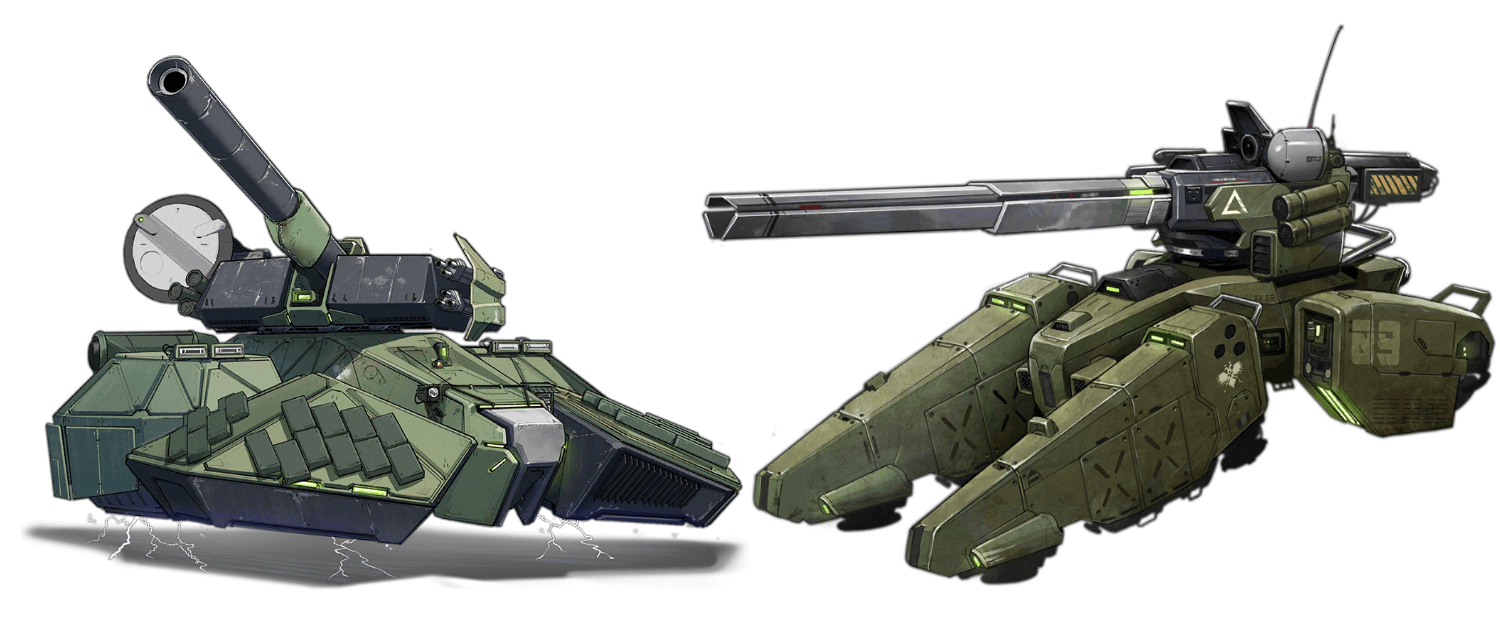
Examples of Soviet tanks in Girls' Frontline. It's unclear if the Coeus and Typhon tanks are unmanned, but we've yet to see any indication of a crew.
Along with the robots, main battle tanks were being converted into unmanned ground vehicles (UGVs). A manned command vehicle in the center of the group would be able to control up to a company-sized armored assault formation at a time. As tanks were becoming drones, the command structure was streamlined. Just a few experienced tank commanders were capable of leading an entire tank regiment in a breakthrough. Later in 2050, multi-legged robots fought alongside Dolls in Southern Italy during the Italian campaign.
Tactical Dolls During WWIII

On the stage is an old, highly modified Doll from the war.
When the war began in 2045, both the Ukrainian Important Operations Prototype and the Romanian Sangvis Ferri fell under the wing of the Soviet Ministry of Defence (MoD). As the ground war continued into its third year, the Soviets realized the severity of their state of affairs. Troop numbers were rapidly declining on all fronts. In 2047, the MoD and the Wartime Defense Council approved the use of Doll robots to maintain supply lines but refused to field weaponized Dolls. For the MoD, the failures faced by the Rippers during the Ukrainian Civil War were far too great to authorize the production of more. Over ten thousand Dolls were built for logistical purposes, giving the Soviets a hefty advantage for their push into Western Europe. However, by 2047, the Soviets’ advance was halted due to the US military arriving in Western Europe earlier that year. Western Europe became a battleground of attrition, leading to overwhelming amounts of casualties. The loss of so many soldiers resulted in the MoD rethinking their stance of using armed Doll robots as ground forces.
American Incursions & Tactical Dolls - 2047
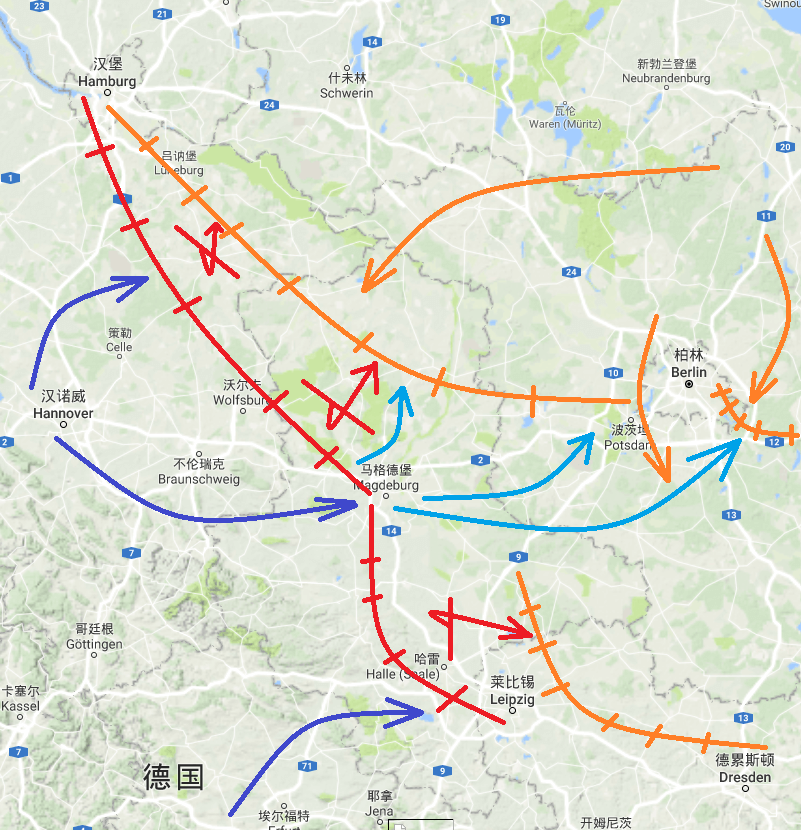
Map of the American invasion into East Germany and the Warsaw Pact fortifications in 2047. This map may not be entirely canonical.
Following the introduction of American troops in Western Europe, the US was swift to carry out several invasions into Germany. When it became clear what the Americans' plans were, the Wartime Defense Council ordered both IOP and SF to immediately begin the production of militarized Doll robots. Both manufacturers went straight to work on their respective Doll robots.
While the Rippers proved almost useless during the Ukraine war, SF innovated the design and used their models’ frames to create multiple new variants of Dolls. The first of the two Dolls based on the Ripper frame was named the “Vespid”. The Vespid line was considerably more effective than the Ripper models, using a standard assault rifle as well as an improved helmet for better vision on the field. The second Doll based on the Ripper was named the “Jaeger”. The Jaegers were a series of sniper Dolls equipped with long-range rifles and great improvements to their vision and sensors. Theoretically, the Rippers and Vespids would take charge on the frontlines while the Jaegers would stay back to provide support or reconnaissance.
When it came to IOP, the company was inexperienced with Tactical-Dolls. Their only creations were labor robots used for reconstruction and the CSD-frame “Nymphs” for service jobs. Regardless, IOP began their work for their first military Doll based on their CSD frame. The company came up with the design of a robot with broad uses in the field, capable of handling standard weapons used by soldiers. The two companies’ design philosophies differed in the use of the robots themselves. Sangvis Dolls were specialized and equipped for specific roles. IOP preferred their Dolls to serve a broad range of roles, with a deeper focus on being able to operate various weapons if the situation required it. In June 2047, both companies submitted their designs to the MoD for approval. The Ministry approved both proposals, and soon after, the pair began production of their Tactical-Dolls. Following production, the Dolls would’ve undergone field testing, but due to the American advance into Berlin in August, the Dolls were sent to war.
Prototype Cyclops - 2048

OBJ-9420 "Uranus" in Girls' Frontline Neural Cloud.
In 2048, Russian military-industrial giant, Svarog Heavy Industries, developed the OBJ-9420 model of Cyclops Tactical Doll. The OBJ-9420 was a combat prototype developed with the intention of replacing the outdated skeletal Dolls as the mainstay of national forces. Its structure implemented various proven technologies including quick-release armor, composite head sensors, and more cost and energy-efficient fourth-generation graphene batteries. Svarog’s research and development also implemented newer technologies including the Easy Damage Self-Repair System, anti-laser coating, and a visual fire control HUD. However, as a means of allowing for the future development of later upgraded generations of mass-produced models, the OBJ-9420 was designed to reserve room for improvement.
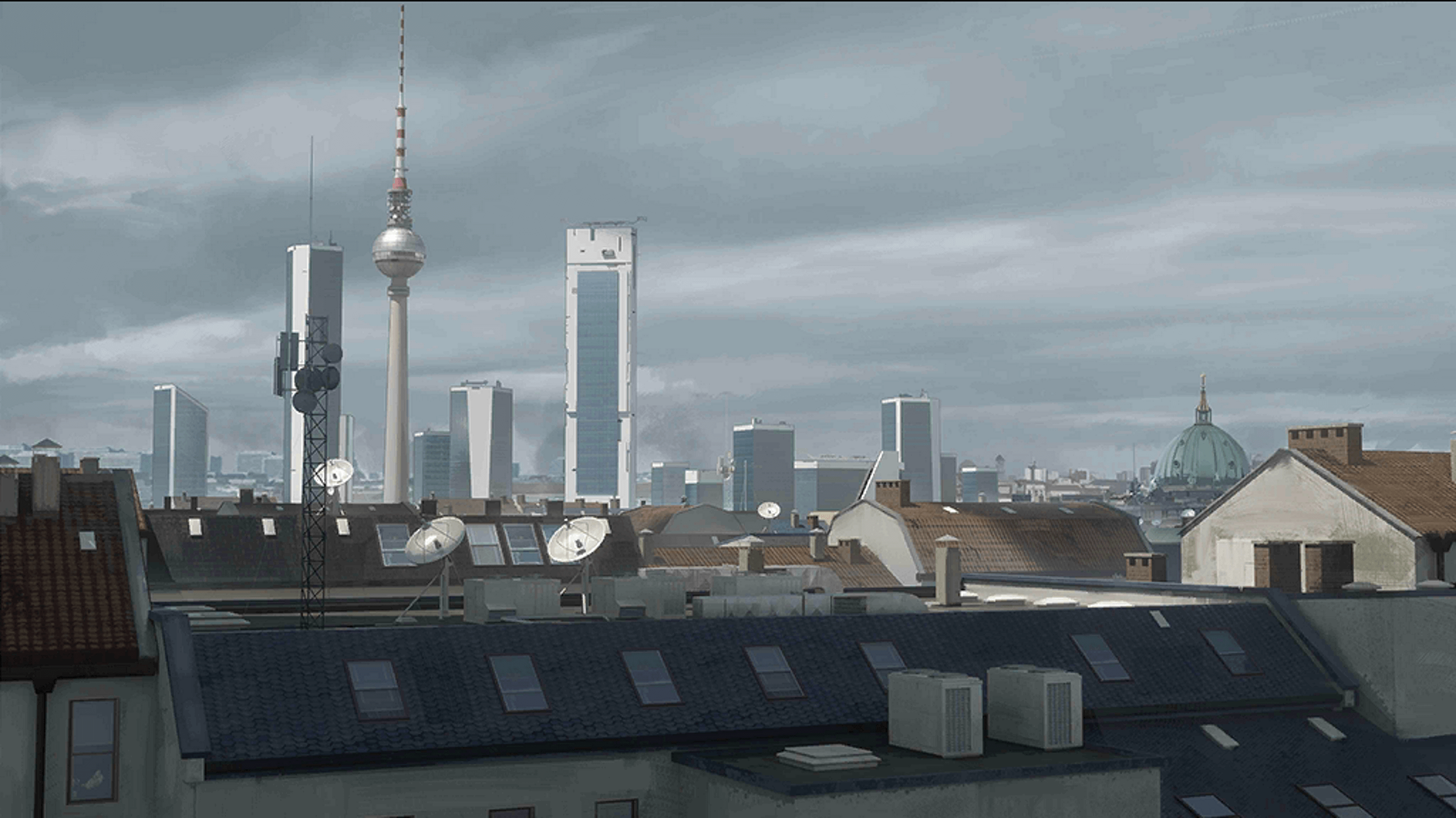
The city of Berlin in late 2064.
In August of 2047, one of the most decisive battles of World War III and successful operations of Doll robots took place. Over 8000 Dolls from IOP and SF were deployed to the frontlines in Berlin to halt the American advance. Despite suffering significant losses, the Soviets’ Dolls managed to stand their ground, putting an end to the enemy’s push in Eastern Germany. Overall, the Dolls proved to be quite useful in their application but still faced a multitude of issues. One of the most glaring issues is that both companies’ Dolls needed to be operated from close range to send and receive orders. Further, their AIs were not capable of adapting to a constantly changing battlefield.
For IOP, their main issue was the number of malfunctions occurring in the field, and for SF, their Dolls lacked the agility needed for a high-intensity conflict. Despite these issues, Dolls were still ultimately successful in their goal. Due to their achievements, many in the MoD were reconsidering the usefulness of Dolls in warfare. One of these men was none other than Carter Neustadt, future Brigadier General of the KCCO. To the officials in the Ministry, Dolls were no longer walking practice targets but a formidable fighting force that could replace human infantry if their problems were solved.
Throughout the war, Doll robots would undergo a series of redesigns and troubleshooting to solve the issues presented during the battle of Berlin. Within three years, both IOP and SF had innovated their designs enough to match basic Soviet infantry, and were even capable of operating autonomously with other robots. Although Dolls were increasingly common among the Soviet military, mixed-human-Doll squadrons were not introduced properly until the 2050s.
Operation Tradewind - 2050-June 2051
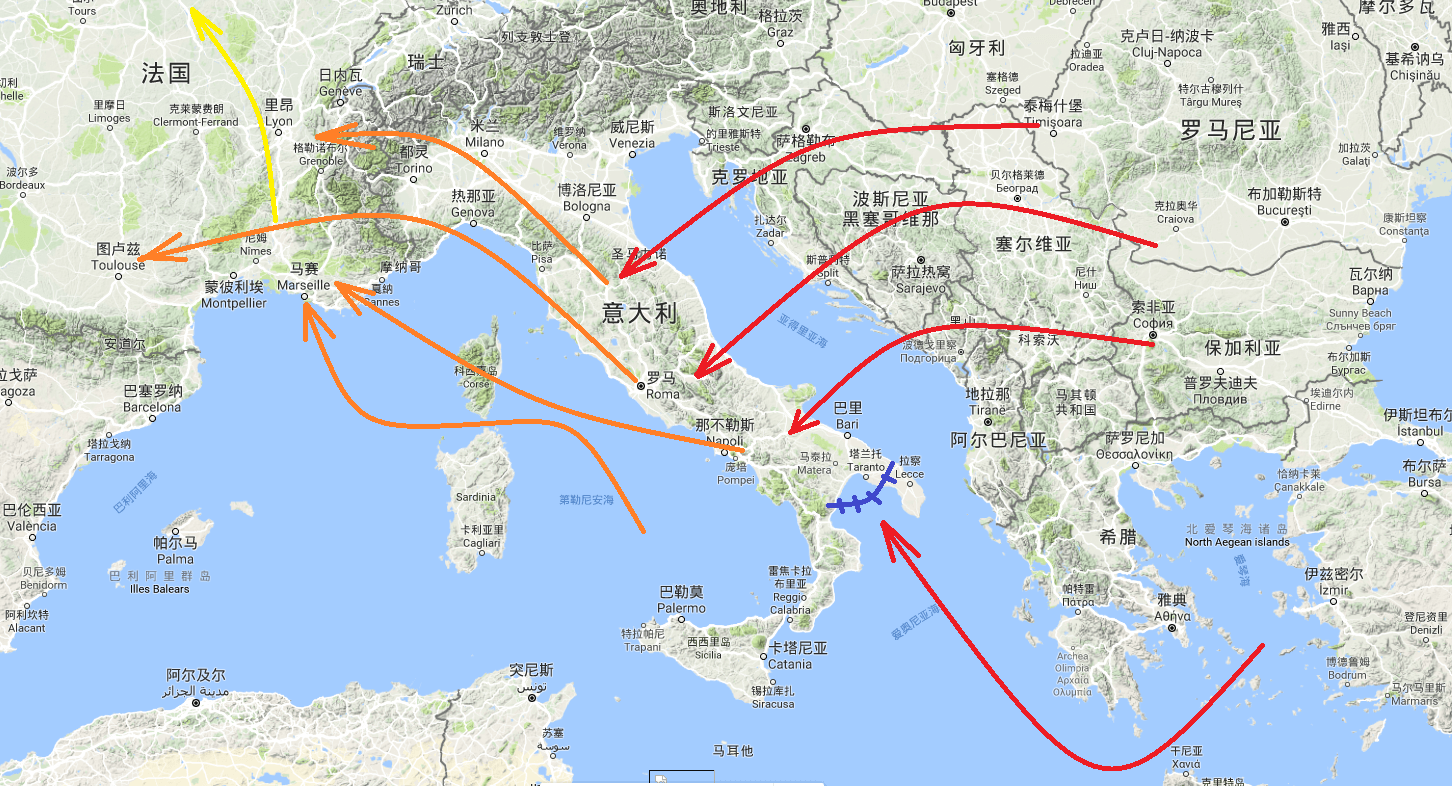
Map of the invasion of Italy and later push in Southern France during Operation Tradewind in 2050-2051. This map may not be entirely canonical.
In an effort to overcome Italy and France, the Soviets carried out “Operation Tradewind” to force Italy and France to surrender. The Soviets deployed several purely robotic groups in Southern Italy to assist in their push towards Rome. Dolls fought alongside various armed multi-legged robots in assaults against Italian fortifications nestled within the Southern mountains. The Soviets were able to continually push forward to Rome thanks to the swift successes of their robotic units. And by the end of the year, Italy had fallen. The Soviets and their allies were on a path to victory in Western Europe, and on June 29th, 2051, the warring nations signed a peace treaty, putting an end to the Third World War. It’s been said the Rossartrists were tied to the end of the war, and considering the Prometheans hoped to control the path WWIII would follow, it’s unsurprising.
Post-War World Order - 2051-Modern Day
Keep in mind that much of what is believed about the state of the world post-WWIII is speculation based on some details.
As the war ended heavily in the Warsaw Pact’s favor, the status quo of the European continent changed. Only a handful of countries have written lore post-war, so this section focuses almost entirely on them.
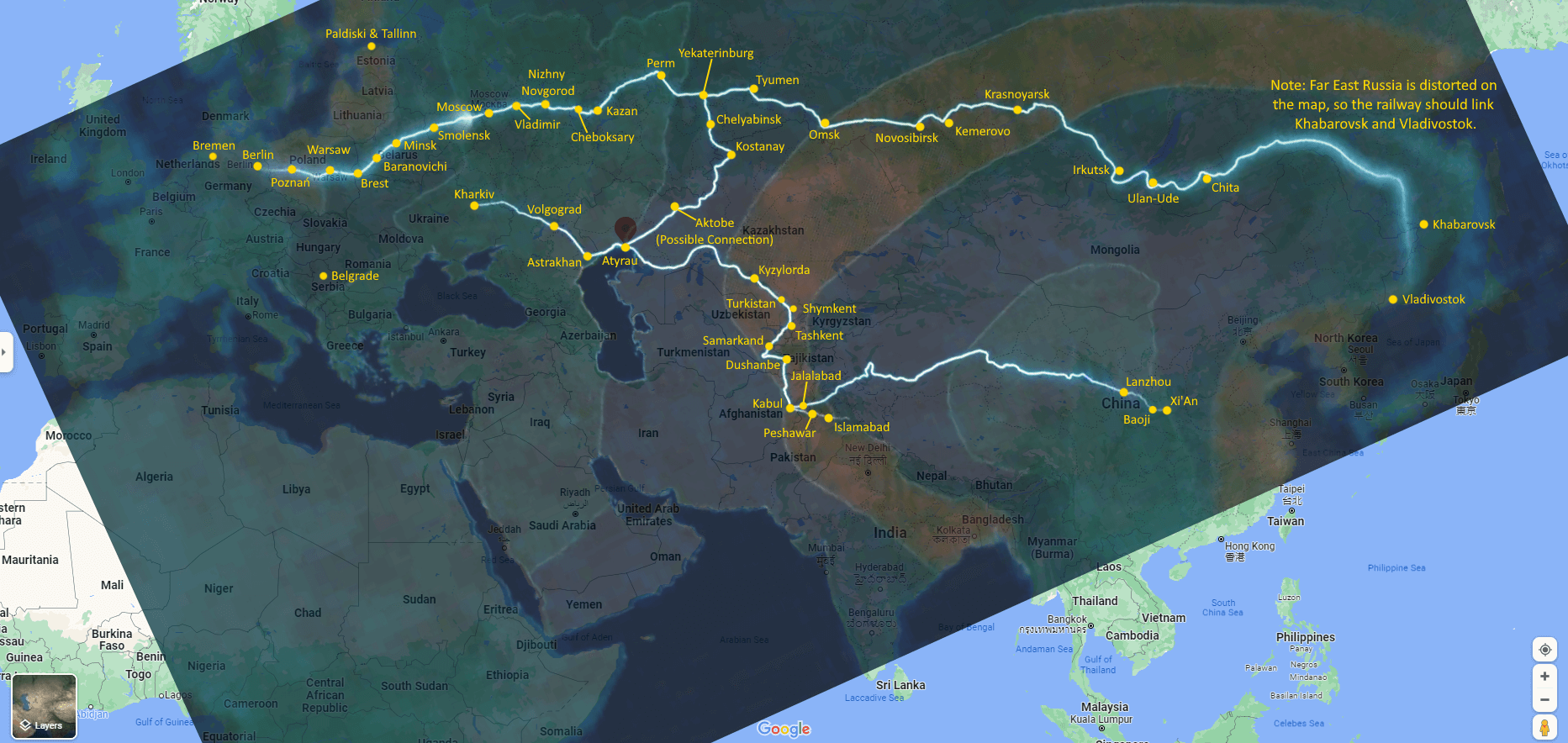
Map of the modern world of Girls' Frontline in October 2064. Due to distortion, this map is not completely accurate.
Warsaw Pact
New Union of Soviet Socialist Republics
The war possibly extended the Soviet borders far past Russia and Belarus. Based on the fact Germany and the NUSSR share a border, it’s believed that the current German-Polish border now stands as the German-Soviet border. Both Poland and Czechia are likely within the NUSSR considering the cities of Warsaw, Kraków, and Prague are monitored by the military and State Security. The Intercontinental Railway passes through the Red Zone in Central Poland, with a strong Soviet and German military presence in the east and west.

Map of the Red Zone in Central Poland in 2064.
Given their proximity to Russia and the state of Estonia in Girls’ Frontline, the Baltic states may also exist within the union. The fact that Kaliningrad is still Russian could further back this belief. After Ukraine was split into East and West Ukraine following the Bucharest Agreement in 2043, the country seems to have been reunified but as a Soviet republic. Not to mention, several Ukrainian cities have been mentioned in the series being within the NUSSR. Given the Soviet MoD brought the Romanian Sangvis Ferri under their wing during WWIII, Romania could’ve been in the NUSSR pre-war. Currently, several other Soviet Socialist Republics have yet to be mentioned.
After the reformation of the UN in 2062, the UN drafted the Alliance of the United Nations Plan. This plan is the first major step towards the formation of the Union of Rossartrism Nations Coalition. In the modern day, Rossartrism is a banned ideology in the NUSSR, but many remain sympathetic to the Rossartrists. Some have even been willing to go as far as to work with the Pan-European Alliance towards this end. For many Soviet ultranationalists, the mere idea of allying with their former enemies was seen as unacceptable. In response to the rise of Rossartrism, the ultranationalists, which include Brigadier General Carter Neustadt, have taken many treasonous actions.
German Democratic Republic
Knowing that the war ended in the Warsaw Pact’s favor, East Germany reunified with West Germany sometime in early October, possibly in 2051, thus unifying all of Germany into the GDR. The former West German Bundeswehr integrated into the Nationale Volksarmee (National People’s Army, NVA). To this day, the German capital remains Frankfurt, but the country is now ruled by the Socialist Unity Party and the State Council. Additionally, the Ministry of State Security (the Stasi) was re-established at an unknown date. While the war had ended, many veterans of the former Federal Republic of Germany (GFR) still held resentment in their hearts as a result of the war’s end and the ongoing refugee situation in Germany. One of the more prominent groups in the GDR is the Free German Independent Party (GIP), a right-wing party designated as a terrorist organization for its violent acts. GIP members symbolize their identities with the Iron Cross medal that was issued by the former GFR Bundeswehr.
Though decontamination and reconstruction continue to this day, several regions have yet to be reclaimed. This includes the "Dead Sea," a WWIII waste dump somewhere in Germany, seemingly outside of Berlin. As a result, the region became an irrecoverable Black Zone with a contamination index still deadly to this day.
People’s Republic of China
Despite being one of the countries involved in the war, little is written about China post-war. After the Chinese managed to push the Americans out of Guangxi in 2049, nothing more was written. Along with many other countries throughout the world, China seems to have decontaminated some of its Yellow Zones. Based on the map of the world from the Longitudinal Strain PV, the capital presumably remains as Xi’An as the Southern line of the Intercontinental Railway ends there. From the same map, much of the eastern seaboard remains a Red Zone.
NATO
Less is known about NATO countries post-war, but given NATO has never been mentioned past WWIII, it can be concluded that the organization collapsed or was dismantled at the war’s end. In the modern day, the former EU and NATO have become the Pan-European Alliance. Many nations within the PEA have embraced Rossartrism and the Alliance of the United Nations Plan.
United States of America
In 2053, General Secretary “Bob” Hampton of the “East Coast American Rossartrism Alliance” (ECARA) spoke to his fellow Rossartrists in the city of Philadelphia. This is the only mention of the ECARA, so details are minimal. Before the outbreak of WWIII, the Prometheans discussed a Soviet victory, and by extension, the need to neutralize North America’s power and influence. Knowing that the United States was one of the first nations to have Rossartrism introduced, the mention of the ECARA may imply the country fractured into civil war at the war's end. As for its cities, only Baltimore has been mentioned in the lore so far. Lastly, nothing has been mentioned regarding the US’ territories after the war, but Canada has been mentioned in Neural Cloud. If the US did fracture, then Canada may have returned to being independent.
United Kingdom of Great Britain and Northern Ireland
In the United Kingdom, the people refused to listen to the calls by their government to rebuild their homes, choosing instead to mellow their sorrows in pubs to deliver some sort of comfort. While the war was over, the scars lingered in their minds. Resentment and anger against the chaos led to the reconstruction of the UK taking far longer, and work effectiveness fell to near lows. By the early 2060s, the UK had been restored to a point far better off than in the immediate postwar era. Notably, London seems to be a center of power for the Prometheus Council. Considering that Rossartre, Sir/Lord Griffin Lyons, and Major General Sir Isaac are all British, this is to be expected.
Italian Republic & French Republic
Aside from the US and the UK, post-war information is sparing from the NATO side. In 2050, the Soviets were planning “Operation Tradewind” to force both Italy and France out of the war, which would bring the war to a close. Considering the war ended the following year in the Soviets’ favor, Italy and France must’ve suffered a devastating defeat. Rome was mentioned to have been attacked near the end of the war, so the loss of Italy is certain. As for France, it remains to be seen if the war ended before or after the Soviets defeated France as well.
Kingdom of Belgium
Although nothing currently has mentioned a battle in Belgium, it would make sense the war must’ve been fought in the country at some point, given the importance of Brussels to the EU and NATO.
The Southern Mediterranean
In 2056, a “Southern Mediterranean no-fly zone” was mentioned, but nothing specific is known about it. On a flight from Andalusia, Spain to Romania, members of the “Shining Holy Land” terrorist group hijacked the plane, forcing the pilot to fly into the “jointly blocked” no-fly zone. As the plane drifted further south, a fighter jet from Cyprus was sent to force the plane to land. Fortunately, thanks to the heroic actions of a certain Soviet military Doll, the terrorists were eliminated, and the plane landed in a suburb of Athens. While the NFZ is mentioned to be jointly blocked, it’s unknown which countries maintained it aside from Cyprus. Furthermore, the NFZ’s current status hasn’t been expanded upon yet.
Aftermath of WWIII & The Impending Disaster - 2051-2052

With the signing of the peace treaty in 2051, the world was left in shambles. Tens of millions were dead, livable land was drastically reduced, industries and economies were crippled, and hopelessness plagued the land. Hope left the hearts of the people in several nations, leading to an unwillingness to rebuild. For the majority of people, the post-war period was one of uncertainty and fear of what could come next; however, one significant issue had been known to nearly everyone. Despite focusing the majority of industrial labor on agriculture, the amount of food needed to feed the people in Europe was too high.
The governments of Europe did not have the resources needed to feed their people, and after North and South America stopped exporting food, it became clear Europe was heading toward a food crisis. Productivity had fallen to levels comparable to the Dark Ages, and the only saving grace, Africa, was in a state of turmoil after a series of civil wars. The loss of arable land in Africa forced governments to review several actions to avoid a potential mass famine. The Warsaw Pact was using POWs to help rebuild devastated regions, agriculture became the main focus of industries, and agricultural robots were taken into consideration. The multi-legged robots once used in World War III were repurposed into agricultural robots and were sent to increase food production in Western Europe and the Iberian Peninsula.

Sir/Lord Griffin Lyons in 2064.
Nearly all industries in every nation were solely focused on agriculture. According to the estimates done by the Prometheus Council, the chances of human civilization surviving were almost nil. And according to Griffin Lyons, a member of the Council, a famine would leave Europe in ruins. Industries within the irradiated zones in Europe and Africa needed to be repaired, or else the consequences would be irreversible. Global reconstruction was needed to ensure humanity’s survival, but all industries were focused on agricultural output. Roughly 45% of light-industrial and 60% of heavy-industrial facilities in the contaminated zones were in a repairable state; however, the plan to restore these regions would be enormous.
The cost of reconstruction would far exceed the tens of billions of rubles spent by the Soviet government during the Lifeline Program. Vast amounts of capital would be needed to carry out the project on time, but the chances of every nation combining efforts to carry out such a task were slim. For Prometheus, only a one-world government would be able to carry out such a massive undertaking. This union of nations would effectively eliminate the bureaucratic red-tape between countries. It’s believed the first phase of Project Prometheus will be completed sometime during the 2060s if a global union of nations is formed.
Symbol of the Union of Rossartrism Nations Coalition established in late 2064.

